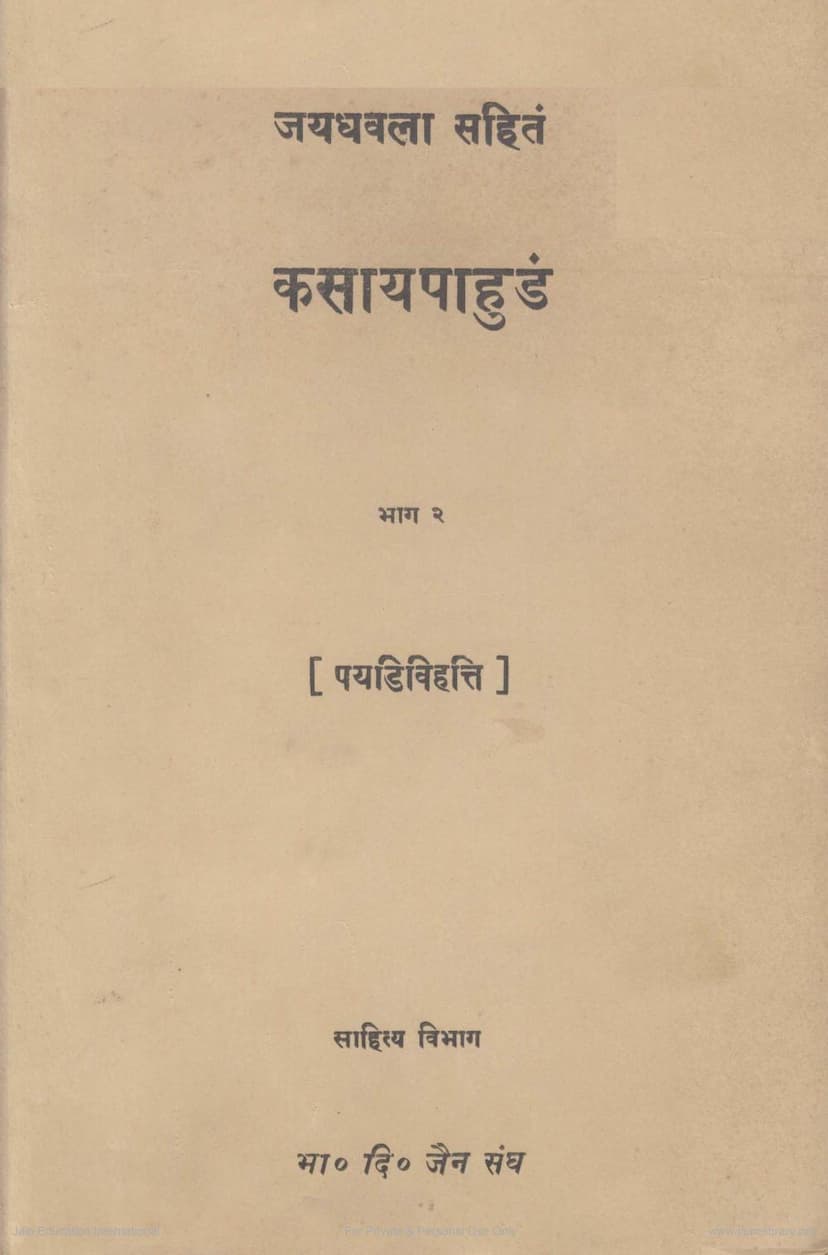Kasaypahudam Part 02
Added to library: September 2, 2025

Summary
Certainly! Here's a comprehensive summary of "Kasaya Pahuda Part 02" (Payadi Vihutti) based on the provided text and catalog link. The text is a part of the foundational Jain scripture Kasaya Pahuda, with extensive commentaries from Jayadhavala and Churni Sutra.
Book Title: Kasaya Pahuda Part 02 (Payadi Vihutti) Author(s): Gundharacharya, Fulchandra Jain Shastri, Kailashchandra Shastri Publisher: Bharatiya Digambar Sangh Catalog Link: https://jainqq.org/explore/001408/1
Overall Focus of the Text:
This volume, "Payadi Vihutti" (अर्थात् प्रकृति विभक्ति), is the second part of Kasaya Pahuda and primarily deals with the intricate details of Mohaniya Karma (कर्म that causes delusion, attachment, and infatuation). It specifically focuses on the Vibhakti (विभक्ति - division, distribution, classification) of Mohaniya Karma, exploring its various aspects such as Prakriti (प्रकृति - nature), Sthiti (स्थिति - duration), and Anubhaga (अनुभाग - intensity of karmic effect). The text delves deeply into these divisions, further categorizing them into Mula Prakriti Vibhakti (मूल प्रकृति विभक्ति - division of the primary nature of karma, referring to Mohaniya itself) and Uttara Prakriti Vibhakti (उत्तर प्रकृति विभक्ति - division of the sub-divisions of Mohaniya Karma).
Key Concepts and Content:
-
Mohaniya Karma's Complex Divisions: The core of this volume is the exhaustive analysis of Mohaniya Karma's subdivisions. It explores how this karma manifests in different states, considering aspects like:
- Satva (Existence): Whether it exists or not.
- Sankhya (Number): How many of its specific types are present.
- Kshetra (Place): Where it is located or manifests.
- Kala (Time): Its duration and when it operates.
- Antara (Interval): The gap between different manifestations.
- Bhava (State/Disposition): The nature of its manifestation.
- Alpabahutva (Quantity Comparison): Comparing the quantity of different karmic manifestations.
- Bhujakara (Indulgence/Enjoyment): How the karma is experienced.
- Padanikshepa (Positioning): The placement or sequence of karmic manifestations.
- Vriddhi (Increase): How the karma grows.
-
Authors and Commentaries: The text is based on the original teachings of Gunadharacharya, elaborated with Churni Sutras by Yativarshabacharya, and further explained by the extensive Jayadhavala commentary of Virasenacharya. The editors, Pandit Phoolchandra and Pandit Kailashchandra Shastri, have meticulously compiled and presented this work.
-
Detailed Analysis of Prakriti Vibhakti: The volume begins by defining "Vibhakti" in its various contexts (nama, sthapana, dravya, kshetra, kala, ganana, samsthana, bhava). It clarifies that the primary focus is on "Karma Vibhakti" concerning Mohaniya Karma.
-
Mula Prakriti Vibhakti: This section describes the distribution of Mohaniya Karma itself, detailing its characteristics across various Anuyoga Dvaras (अनुयोगद्वार - analytical perspectives or methods of inquiry), including:
- Samutkiratana (Statement/Enumeration): Discussing its existence across different Gunasthanas (गुणस्थान - stages of spiritual development) and Marganas (मार्गणा - paths or conditions of existence).
- Ownership (Swamitva): Identifying who possesses the karma.
- Time (Kala): Its duration and when it operates.
- Interval (Antara): The time gaps.
- Bhangavichaya (Analysis of permutations/combinations): Examining how different permutations of karmic presence and absence occur across various beings.
- Bhagabhaga (Proportional distribution): Analyzing the proportion of beings with and without the karma.
- Parimana (Quantity): The total quantity.
- Kshetra (Place): The spatial distribution.
- Sparshana (Contact/Touch): The temporal and spatial reach.
- Bhava (Disposition): The different states of the soul in relation to the karma.
- Alpabahutva (Quantity comparison): Comparing the number of beings involved.
-
Uttara Prakriti Vibhakti: This section delves into the subdivisions of Mohaniya Karma. It is further divided into:
- Ekaika Uttara Prakriti Vibhakti (एकैक उत्तर प्रकृति विभक्ति): An individualistic description of each of the 28 subdivisions of Mohaniya Karma.
- Prakriti Sthana Uttara Prakriti Vibhakti (प्रकृतिस्थान उत्तर प्रकृति विभक्ति): The distribution of these subdivisions across various Prakriti Sthanas (प्रकृतिस्थान - states determined by the number of karmas present), ranging from 28 Prakritis down to 1 Prakriti. The text meticulously lists these 15 possible Sattva Sthanas (सत्त्वस्थान - states of karmic existence).
-
Inclusion of Mathematical Concepts: The text is notable for its sophisticated use of mathematical concepts, particularly in the Alpabahutva (अल्पबहुत्व - comparison of quantities) and Bhanga (भंग - permutation) sections. It outlines complex methods for calculating permutations and combinations related to the presence and absence of various karmic states across different beings and conditions.
-
Discrepancies and Elaborations: The preface by the publishers highlights some minor delays in publication due to changes in personnel and the complexity of the work. It also acknowledges the significant assistance received from mathematical professors for clarifying certain complex sections related to Karana Sutras (करण सूत्र - formulas related to karmic processes).
In essence, "Kasaya Pahuda Part 02 (Payadi Vihutti)" is a highly technical and detailed Jain scripture focused on the exhaustive classification and analysis of Mohaniya Karma. It employs sophisticated logical and mathematical frameworks to understand the manifestation and distribution of this critical karma, providing profound insights into the Jain understanding of the soul's bondage and liberation.